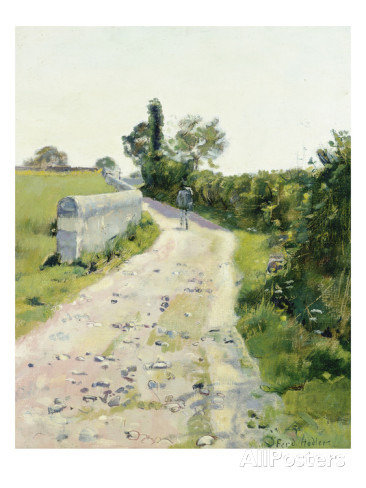Ferdinand Hodler and Jean-Frederic Schnyder
dal 11/9/2014 al 25/4/2015
Segnalato da
11/9/2014
Ferdinand Hodler and Jean-Frederic Schnyder
Kunsthaus Zurich, Zurich
Curated by the artist Peter Fischli, the exhibition focuses on two central and very different practitioners of Swiss painting. Fischli focuses on the creative processes of two characteristic representatives of Swiss art: one a celebrated and pivotal master of the transition to Modernism, the other an artist who brought key new ideas to bear following the end of a Modernism become classical.

From 12 September 2014 to 26 April 2015 the Kunsthaus Zürich is staging an
exhibition curated by the artist Peter Fischli that focuses on two central and
very different practitioners of Swiss painting: Ferdinand Hodler (1853-1918)
and Jean-Frédéric Schnyder (b. 1945). Incorporating some 180 works, it
highlights commonalities and differences, and includes a few surprises.
Realised by the artist Peter Fischli for the Kunsthaus, this exhibition centres on
a selection of drawings and paintings by Ferdinand Hodler from the Kunsthaus’s
own collection, including landscapes, nature studies, figure compositions and
portraits. Jean-Frédéric Schnyder’s image cycles ‘Berner Veduten’ (‘Bernese
Views’, 1982–1983) and ‘am Thunersee’ (‘on Lake Thun’, 1995) are linked to the
Hodlers conceptually. Fischli focuses on the creative processes of two
characteristic representatives of Swiss art: one a celebrated and pivotal master
of the transition to Modernism, the other an artist who brought key new ideas to
bear following the end of a Modernism become classical. The landscape, studied
and painted in the open air, plays a key role in both cases. The presentation
emphasizes the features common to both artists but also highlights the
dissimilarities. For curator Peter Fischli, the concept of dissimilarity is indeed
the unspoken title of the exhibition.
THE EVERYDAY VERSUS THE SUBLIME
In 1970-71, after contributing to the legendary ‘When Attitudes Become Form’
exhibition at the Kunsthalle Bern in 1968, Schnyder made his first ventures into
the field of painting. The ‘Bernese Views’ (1982-83) saw this engagement gaining
greater depth and importance. With no studio to work from at the time, the artist
had no option but to strap his easel to his back and take to his bicycle, day after
day, painting 106 motifs from Bern and the surrounding area in the style of
plein-air painting. From nature and the city to the charming and the ugly, and
from Migros supermarket to Minster, the cycle boasts a formidable wealth of
motifs. Schnyder’s goal was painting as a process devoid of judgments: painting
per se. Study drawings and installational objects by the artist complete the
presentation. Deployed as part of the creative process, tools such as a racing
bike, hiking boots, a rucksack and an easel are transformed into sculptures. The
differences from the work of Hodler are striking. For Switzerland’s greatest
painter of the late 19th and early 20th centuries, everything revolves around
judgment, emphasis, elaboration – and sublimation. In Hodler, grand form
enables us to experience human being and landscape in their relationship to an
intellectual sense structure.
NIESEN AND NIEDERHORN
Hodler typically painted his landscapes in the open air. The ‘Bernese Views’
were Schnyder’s first, cheerfully earnest foray into this method of painting. The
1995 cycle comprising views of Lake Thun placed him squarely in Hodler’s
territory. The Niesen, for example, is a Hodler mountain par excellence.
Schnyder, whose technique had acquired greater subtlety between the ‘Bernese
Views’ and the Lake Thun paintings, depicted it on a number of occasions along
with the Niederhorn, its counterpart on the opposite side of the lake. Unlike in
the views, here he concentrates primarily on two motifs. The locations are the
same; it is the meteorological, atmospheric and energy conditions that change.
Sometimes the mountains almost stand out; sometimes they are enveloped in
clouds. While Hodler always sought the sublime instant, with Schnyder we
alternate between the presence and absence of the ideal painterly moment. The
act of painting itself is the only constant.
PAINTING ABOUT PAINTING
In Hodler, painting was already an omnipresent theme. For all their differences,
then, the major feature that the two artists’ works share is that they deal first
and foremost with painting itself. Moving beyond iconography and
categorizations, the presentation allows us to share the artists’ perspectives on
the translation of the world into painting. The selection and exhibition design by
Peter Fischli – an important contemporary artist bringing a fresh eye to Hodler
the Old Master – make for a presentation that is both unique and unparalleled.
WORKS LONG UNSEEN
The Kunsthaus, which holds several hundred works by Ferdinand Hodler, left
the choice of exhibits to Peter Fischli. With some 22 paintings and 61 drawings,
the presentation includes an impressive array of Hodlers. The fragile works on
paper will be exchanged half-way through the exhibition. Jean-Frédéric
Schnyder’s work is represented by more than 100 pieces dating from between
1982 and 1995. They have been loaned by both private collectors and prominent
Swiss museums including the Aargauer Kunsthaus, the Kunstmuseum Basel
and the Kunstmuseum Bern, the Bündner Kunstmuseum, the Migros Museum
für Gegenwartskunst and the Collection Pictet.
Admission is included in the normal entrance fee and is free on Wednesdays.
There are public guided tours regularly and on various days of the week.
Registration is not required. Further information can be found in the events
calendar at www.kunsthaus.ch.
Supported by the Vontobel Foundation and the Erna and Curt Burgauer
Foundation.
Image: Ferdinand Hodler, Sunny Path, around 1890. Oil on canvas, 41 x 33 cm. Kunsthaus Zürich
Contact: Kunsthaus Zürich, Press & Public Relations
Kristin Steiner, kristin.steiner@kunsthaus.ch, tel.: +41 (0)44 253 84 13
PRACTICAL INFORMATION
Kunsthaus Zürich
Heimplatz 1, CH–8001 Zurich
Opening hours: Fri-Sun/Tues 10 a.m. – 6 p.m., Wed, Thurs 10 a.m. – 8 p.m.
Public holidays: Christmas 24/26 December, 31 December, 1/2 January 2015, 10
a.m. – 6 p.m.
Admission to the Hodler/Schnyder exhibition including the collection: CHF 15 /
CHF 10 (concessions and groups), Children and young people up to the age of 16
free of charge. Admission free on Wednesdays



